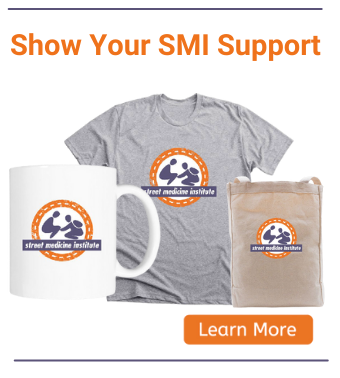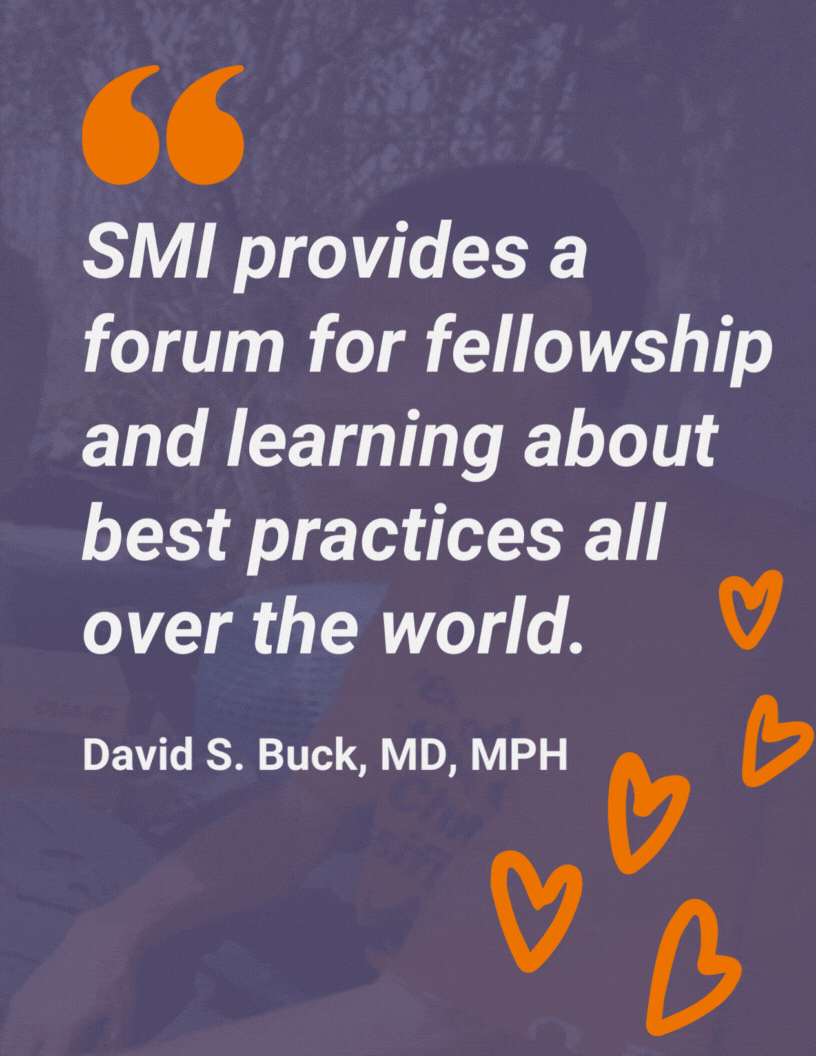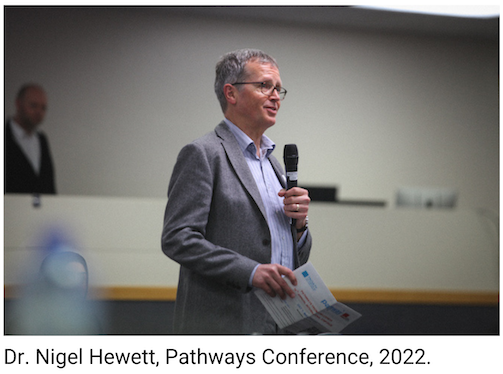 Tribute to Dr. Nigel Hewett by Andrew Hayward, Director of the UCL Institute of Epidemiology and Health Care and Co-Director of the UCL Collaborative Centre for Inclusion Health and colleagues at CCIH
Tribute to Dr. Nigel Hewett by Andrew Hayward, Director of the UCL Institute of Epidemiology and Health Care and Co-Director of the UCL Collaborative Centre for Inclusion Health and colleagues at CCIH
 Dr. Nigel Hewett retired this summer after 12 years as the founding medical director of Pathway. He was also the founding Secretary and the driving force behind the development of the UK Faculty for Homeless and Inclusion Health, which we launched in 2011. I first met Nigel when Pathway’s founder, Professor Aidan Halligan, invited me to see a new specialist homeless service at University College Hospital in London (I didn’t realize at the time but Aidan was also checking me out as a potential CEO, for an organization that didn’t yet exist). Nigel was there following a similar experience.
Dr. Nigel Hewett retired this summer after 12 years as the founding medical director of Pathway. He was also the founding Secretary and the driving force behind the development of the UK Faculty for Homeless and Inclusion Health, which we launched in 2011. I first met Nigel when Pathway’s founder, Professor Aidan Halligan, invited me to see a new specialist homeless service at University College Hospital in London (I didn’t realize at the time but Aidan was also checking me out as a potential CEO, for an organization that didn’t yet exist). Nigel was there following a similar experience.
Read More
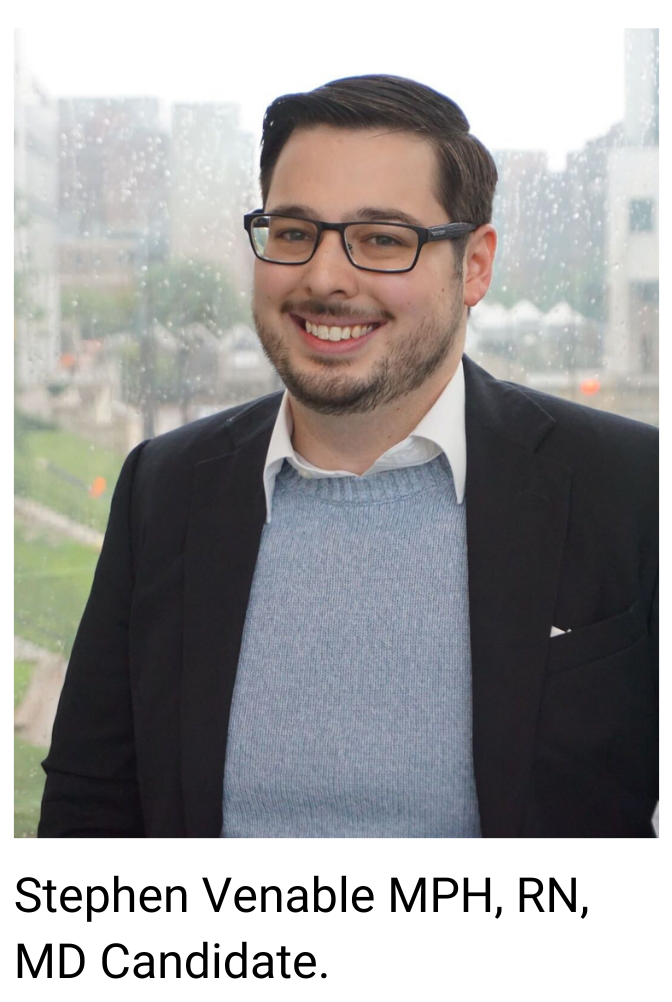
Dear Street Medicine Family,
As the year prepares for its end, we would like to take a moment to thank the Street Medicine Institute Student Coalition Board of 2021/2022 for all their hard work and dedication. This includes our outgoing Chief Coordinator, Sophie Roe, who has been an exemplar of leadership, dedication, and kindness throughout the last year. During her time leading SMISC, she has helped strengthen the core of our organization, and I know that, due to her efforts, we stand in a much better position to help our fellow students care for our friends on the street. We also wanted to wish the best to our outgoing board members Kerina Yao and Sarah Hludzinski as they move on to their next phases. We know that they both will continue making a difference in the lives of others no matter where they go, and we could not be prouder of them for it.
Read More
Guest Post: Liability, Malpractice, & Safety Policies In Academic-Based Street Medicine Programs: A Workshop Summary from ISMS 2022
 There were many facets of the COVID-19 pandemic that considerably impacted the lives of persons experiencing homelessness. In response, individuals and families composing the homeless population adapted. The same was true for organizations serving the community. Shelters adapted their floor plans to increase “social distancing”; large-venue congregant shelters opened to accommodate the increased numbers of individuals who found themselves without housing; restrictions on outdoor camping were loosened which in turn made homelessness far more visible; cities struggled with new issues of allowing ‘tent cities’ in parks and parking lots regardless if they were officially sanctioned or not; agencies serving the population fiscally re-evaluated increased need for services with decreased funding from donations; everyone worried about the virus and simply surviving through the worst of the pandemic.
There were many facets of the COVID-19 pandemic that considerably impacted the lives of persons experiencing homelessness. In response, individuals and families composing the homeless population adapted. The same was true for organizations serving the community. Shelters adapted their floor plans to increase “social distancing”; large-venue congregant shelters opened to accommodate the increased numbers of individuals who found themselves without housing; restrictions on outdoor camping were loosened which in turn made homelessness far more visible; cities struggled with new issues of allowing ‘tent cities’ in parks and parking lots regardless if they were officially sanctioned or not; agencies serving the population fiscally re-evaluated increased need for services with decreased funding from donations; everyone worried about the virus and simply surviving through the worst of the pandemic.
Read More
Jim Withers, MD and Joel Hunt, PA 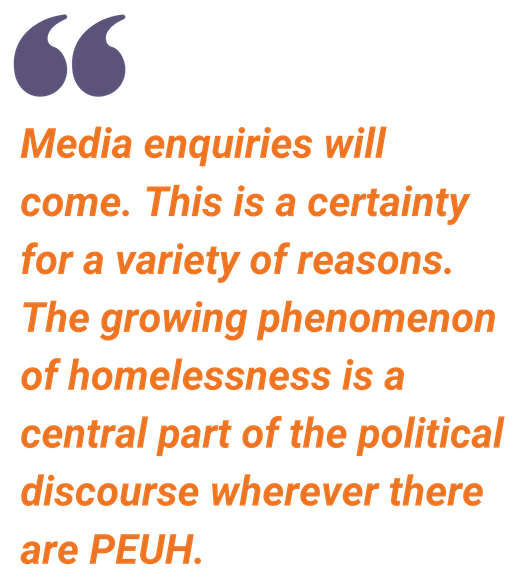 The act of providing direct medical care to those living on the streets is not just an important service, but one that provokes society. Time and again, street medicine programs activate the attention of the public and the media. This is an almost guaranteed part of the street medicine journey and deserves discussion. This paper is not a definitive work on the subject of media relations, but hopefully serves as a guide based on many decades of experience by street medicine experts.
The act of providing direct medical care to those living on the streets is not just an important service, but one that provokes society. Time and again, street medicine programs activate the attention of the public and the media. This is an almost guaranteed part of the street medicine journey and deserves discussion. This paper is not a definitive work on the subject of media relations, but hopefully serves as a guide based on many decades of experience by street medicine experts.
Read More
Jim Withers' Story
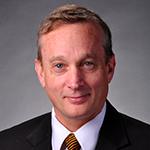
Dr. Jim Withers is the Founder of the Street Medicine Institute. The Institute evolved as an off-shoot of his groundbreaking work with Pittsburgh Mercy's Operation Safety Net, the street medicine program he established and continues to work with in Pittsburgh, PA. Dr. Withers describes his experience with street medicine in his Ted Talk here.
Read More
Guest Post: Writing a Human Rights Prescription for Governments: How the street medicine movement can leverage human rights law for transformative change
At the heart of both street medicine and human rights stands one animating principle: dignity. Anyone who practices street medicine understands that homelessness constitutes an affront to human dignity. To bear witness to systemic violations of human dignity, and stand in solidarity with those who experience it, is the daily work of street medicine practitioners. Practitioners in this field can vividly describe the dehumanization experienced by people who are unhoused – ritualized in our legal systems, our social services, our streets, our schools, and yes – our healthcare systems.
Read More
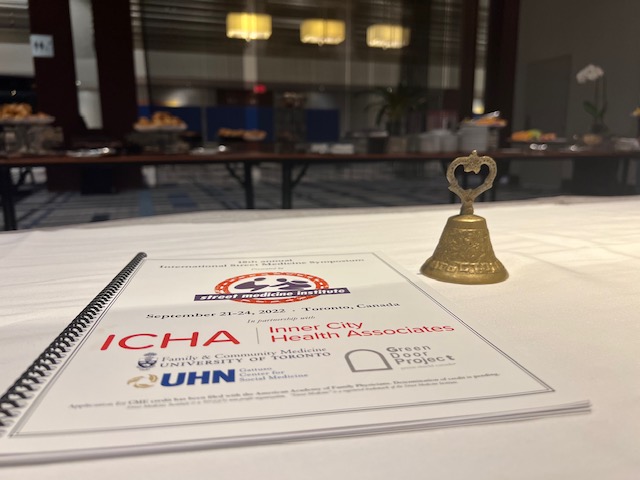 All of us at Inner City Health Associates (ICHA) were so thrilled to host the 18th International Street Medicine Symposium in Toronto from September 21st – 24th this year! It had been such a long and gruelling time for all since we were all able to get together and we were so galvanized and inspired by the passion, kindness, commitment and innovative work being done throughout the world for to support the health and housing of unsheltered people and communities.
All of us at Inner City Health Associates (ICHA) were so thrilled to host the 18th International Street Medicine Symposium in Toronto from September 21st – 24th this year! It had been such a long and gruelling time for all since we were all able to get together and we were so galvanized and inspired by the passion, kindness, commitment and innovative work being done throughout the world for to support the health and housing of unsheltered people and communities.
Read More
Congrats On An Amazing ISMS 18!
What an amazing symposium we all just witnessed a few short weeks ago! I had such a great week and wish to congratulate and thank many of you who helped make it so successful:
Read More
18 Things We Learned From #ISMS18
Here are 18 things we learned from #ISMS18, by the Street Medicine Institute Student Coalition.
Read More
We are currently looking for more people who want to be involved with the Street Medicine Educator Coalition! Learn more about the Educator Coalition. Currently, we have opportunities for positions on our Leadership Team and Education Work Group.
Read More
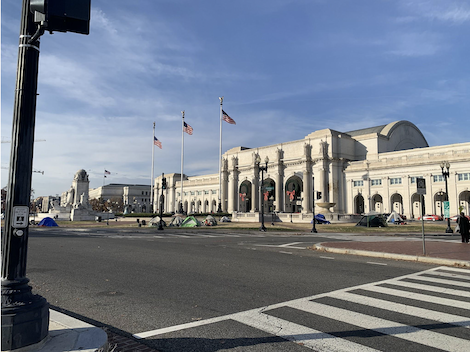 There’s something jarring about walking towards the U.S. Capitol and being surrounded by rows of tents that so many District of Columbia residents call home. Just blocks from the White House, there are encampments of people living without adequate shelter, access to food, or healthcare. In a city rich with resources and arguably the center of power in the United States, nowhere is it more obvious where we as a nation have made the political choice to intentionally value certain lives over others.
There’s something jarring about walking towards the U.S. Capitol and being surrounded by rows of tents that so many District of Columbia residents call home. Just blocks from the White House, there are encampments of people living without adequate shelter, access to food, or healthcare. In a city rich with resources and arguably the center of power in the United States, nowhere is it more obvious where we as a nation have made the political choice to intentionally value certain lives over others.
Read More
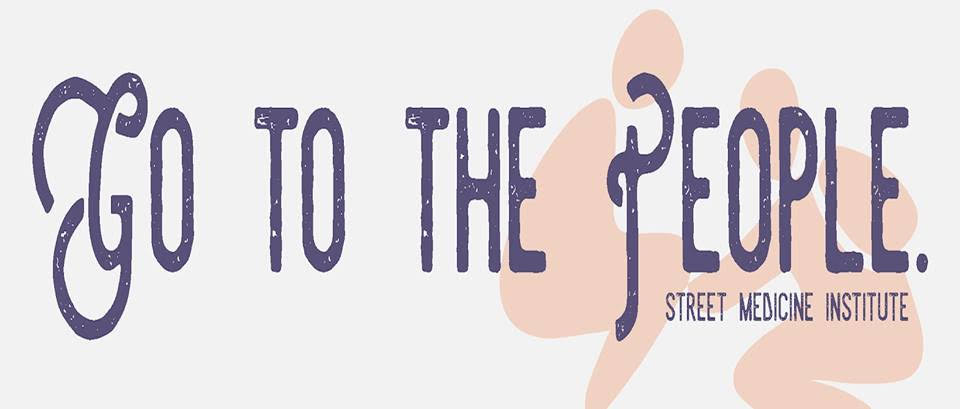
Dear Student Coalition,
The application process is now open, and all students are invited to apply for the 2022-2023 Street Medicine Institute Student Coalition (SMISC) Leadership Team! You will find the application link at the bottom of this message.
Read More
Narratives
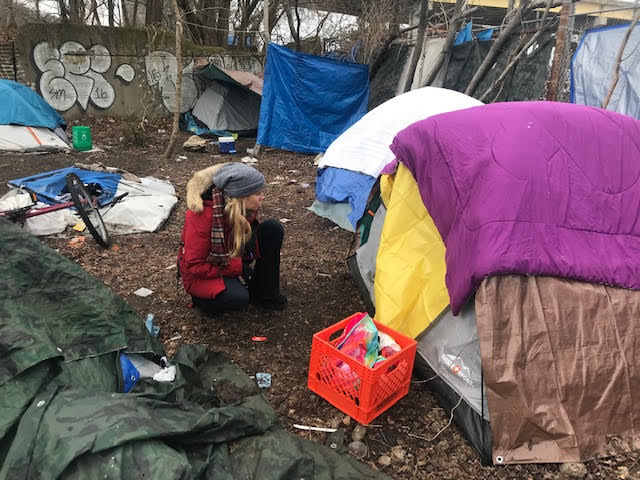 Out in the water - someone is flailing as they struggle to keep their head above the surface. They look exhausted. A bystander dives into the waves to help them swim back to the shore. Later, the bystander gets asked about their actions...
Out in the water - someone is flailing as they struggle to keep their head above the surface. They look exhausted. A bystander dives into the waves to help them swim back to the shore. Later, the bystander gets asked about their actions...
Read More
Staying in Touch with My Humanity
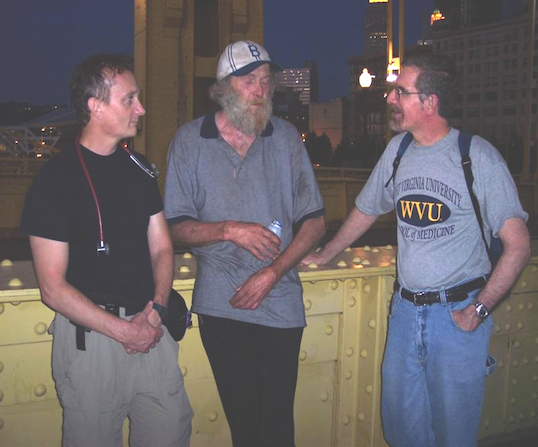 I will be the first to admit it. Even though I am a “child of the sixties”, my personal and professional life have generally followed the straight and narrow. Yet, I always felt motivated by the challenging words and actions of John F. Kennedy, Martin Luther King, Jr, St. Teresa of Calcutta, and Paul Farmer. And, what about the admonition from the New Testament: “Whatsoever you do to the least of my brothers and sisters, so you do unto Me”? Even my high school teacher charted my trajectory with the adage “To whom much is given, much is to be expected”.
I will be the first to admit it. Even though I am a “child of the sixties”, my personal and professional life have generally followed the straight and narrow. Yet, I always felt motivated by the challenging words and actions of John F. Kennedy, Martin Luther King, Jr, St. Teresa of Calcutta, and Paul Farmer. And, what about the admonition from the New Testament: “Whatsoever you do to the least of my brothers and sisters, so you do unto Me”? Even my high school teacher charted my trajectory with the adage “To whom much is given, much is to be expected”.
Read More
Maintaining Solidarity with the Street and with Each Other: A Guide to Street Medicine Practice in Cities with Multiple Programs
 NEW RESOURCE -
NEW RESOURCE -
Maintaining Solidarity with the Street and with Each Other: A Guide to Street Medicine Practice in Cities with Multiple Programs
by Brett Feldman, PA-C and Jim Withers, MD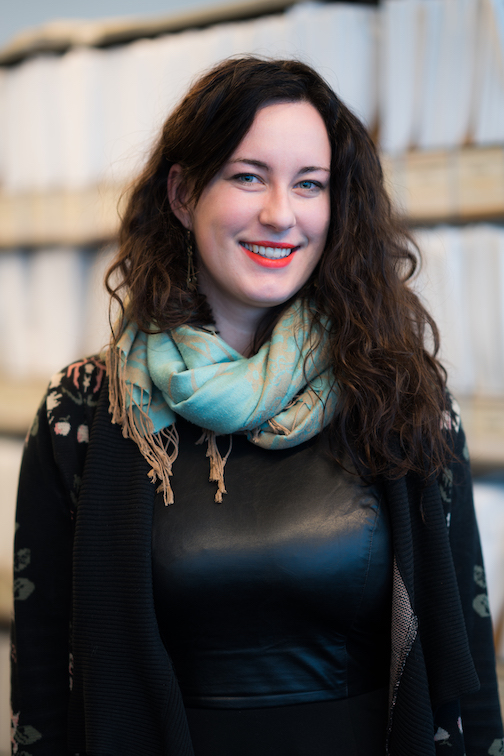 Dr. Kaitlin Schwan is Executive Director of the Women’s National Housing and Homelessness Network and a Senior Researcher at the Canadian Observatory on Homelessness. She teaches social policy at the University of Toronto’s Faculty of Social Work, where she is appointed Assistant Professor, Status Only. She is the former Senior Researcher for the UN Special Rapporteur on the Right to Adequate Housing and Director of Research for The Shift, where she worked in countries around the world to advance the right to housing. Dr. Schwan completed her PhD in Social Work at the University of Toronto in 2016 and has over 15 years of research and policy practice focused on homelessness prevention and human rights, particularly for women and youth. She uses research to build bridges between evidence, advocacy, policy, and lived expertise to advance housing justice in Canada and internationally.
Dr. Kaitlin Schwan is Executive Director of the Women’s National Housing and Homelessness Network and a Senior Researcher at the Canadian Observatory on Homelessness. She teaches social policy at the University of Toronto’s Faculty of Social Work, where she is appointed Assistant Professor, Status Only. She is the former Senior Researcher for the UN Special Rapporteur on the Right to Adequate Housing and Director of Research for The Shift, where she worked in countries around the world to advance the right to housing. Dr. Schwan completed her PhD in Social Work at the University of Toronto in 2016 and has over 15 years of research and policy practice focused on homelessness prevention and human rights, particularly for women and youth. She uses research to build bridges between evidence, advocacy, policy, and lived expertise to advance housing justice in Canada and internationally.
Founder's Letters: A Brief History of the International Street Medicine Symposium
As we approach the 18th International Street Medicine Symposium in Toronto this September, we thought it would be a good time to provide some background on our annual meeting. Around 2004, I was approached by a funder who wanted to support the replication of the “Operation Safety Net model” of street care. Although not entirely unique, it was one of only a few programs truly committed to full time medical street work. The first other program I learned about was Calcutta Rescue under the leadership of Dr. Jack Preger in India. When I visited Jack in December of 1993, the experience was an epiphany. I will never forget the feeling of realizing I was not alone. Prior to that, I thought I might be the only physician crazy enough to provide medical care under bridges. Even though Pittsburgh and Kolkata were radically different, the same forces of exclusion and the same passion for social justice were obvious. Not long thereafter, I learned of the Boston Healthcare for the Homeless program and the pioneering work of Jim O’Connell and his colleagues. After visiting them on street rounds, I knew this was a new field of medicine – even if it did not yet have a name.
Read More
 Now in its second year, the Seed Grant program has been designed to assist eligible entities in the creation of new Street Medicine programs in their local communities. The program facilitates and enhances the direct provision of health care to the unsheltered homeless where they live by providing communities and clinicians with expert training, guidance, and support to develop and grow their own Street Medicine programs. This year, we were delighted to have received over twenty deserving and qualified applications.
Now in its second year, the Seed Grant program has been designed to assist eligible entities in the creation of new Street Medicine programs in their local communities. The program facilitates and enhances the direct provision of health care to the unsheltered homeless where they live by providing communities and clinicians with expert training, guidance, and support to develop and grow their own Street Medicine programs. This year, we were delighted to have received over twenty deserving and qualified applications.


